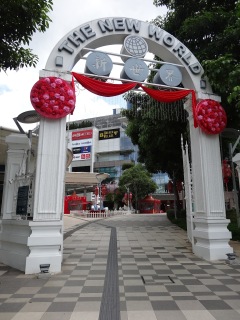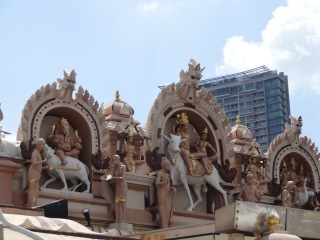As recently as 1924 Syed Alwi Road ran alongside a swampland. The road is thought to be named after decedents of the prophet Mohammed who were a prominent part of Singapore’s community for 190 years. They were traders and land owners who shared their wealth with the local community. They donated land and contributed to the building of Singspore’s oldest mosque, Masjid Omar Kampong Melaka (off Havelock Road). The shophouses on this road were built between the 1800s and 1960s with many excellent architectural styles preserved here today. The banks of the Rochor River between Syed Alwi Road and Jalan Besar were once occupied by a village of pondoks (communal houses on stilts).
In 1923, a few years after the trauma of the First World War, New World opened as an entertainment venue just off Serangoon Road. It hosted everything from boxing and wrestling to cabaret. It also included a dance hall where up to 500 couples could dance the waltz, tango, rhumba or foxtrot to live music. There was opera, a Ferris wheel, merry-go-round and film screenings. Although it was damaged during the Second World War it was repaired and continued to thrive until the 70s. It then started to decline with the arrival of television and later home video. Eventually it was demolished to make way for a new condo but the original arch was moved to City Green Park at the junction of Serangoon and Kitchener roads where the New World memory can live on.
Perhaps one of Singapore lesser known faiths the original Sikh temple was a community bungalow. It was converted into a proper temple in 1921 and in 1984 moved to new premises where it still serves the Sikh community today. The temple includes a kitchen, as an important custom of the faith is to provide food and lodging to Sikh travelers. Today around 12,000 Singaporeans are of Sikh origin.
As the longest river in Singapore the Kallang River also drains one sixth of the islands land area. It was once home to the Orang Laut (Sea Nomads) who lived on boats on the swamp. During the 1960s the Housing Development Board started to fill in and reclaim the basin swampland and mudflats. Later the Ministry of Environment started a clean-up project aimed to turn the waterways into a clean and pleasant environment. Even as late as 1977 waste and rubbish was being dumped directly into the river, rotting carcases from local pig and duck farms along with sewage were making the water unsuitable for aquatic life. A huge project relocated 26,000 families, phased out farms and finally dredged the river. Now landscaped with walkways and home to water sports the river is today very far removed from its relatively recent squalor.
Chwee Kang Beo Temple was once used by the shanty towns and shacks that lined the Kallang basin. Originally a wooden shed that floated by the riverside, Chwee Kang Beo means Water River Temple in Hokkien. The original stilted structure survived until 1979 when the temple was rebuilt on solid ground. This new temple would suffer from flooding during high spring tides but today the Marina Barrage protects it.






